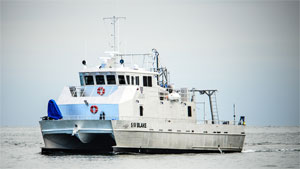Commissioned in 1874, the original 148-foot survey steamer/schooner George S. Blake is credited with the first oceanographic survey of the Gulf of Mexico among other accolades for innovation in hydrographic surveying history.
In October 2014, the 82-foot S/V Blake was delivered to the Marine Services Division of David Evans and Associates Inc. at Gulfport, Miss. The aluminum catamaran was designed by Fyffe Yachts of Kemah, Texas. It was built at Geo Shipyard in New Iberia, La.
Evans, an engineering company based in Portland, Ore., is employing Blake on a contract with the National Oceanic and Atmospheric Administration (NOAA) to conduct hydrographic surveys in the Gulf of Mexico, utilizing state-of-the-art hydrographic instruments. Blake’s first assignment is charting the seabed of Gulfport Channel and Chandeleur Sound.
“We are updating NOAA’s nautical charts of the area with modern technology to determine discrepancies between existing charts and new information gathered from the survey’s seabed scan,” said the project’s lead hydrographer, John Staly.
The catamaran’s stability, fuel efficiency, high transit speed and station-keeping attributes will be put to the task.
“We are utilizing a side-scan sonar to image the seafloor to search for obstructions and a multi-beam bathymetric sonar to acquire general depth information as well as minimum depth on obstructions that pose a threat to navigation,” said Jon Dasler, Evans’ director of marine services.
While mapping the Gulf of Mexico in the late 19th century, George S. Blake made hydrographic history utilizing innovative technology, notably the Pillsbury current meter and the Sigsbee deep-sea sounding machine.
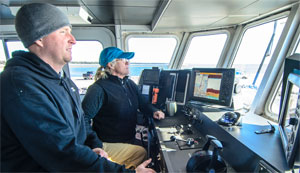 |
|
Capt. J.B. McLendon and Capt. Rosanne Weglinski stand watch in the 82-foot catamaran. |
Today, Blake is equipped to deploy precise survey-grade multi-beam bathymetric sonar secured to a retractable strut lowered into the water via a moon pool. In addition, a seafloor imaging side-scan sonar, similar to the one used in locating HMS Titanic, is towed behind the vessel by means of a stern A-frame and winch wound with 6,560 feet of cable. The side-scan sonar can be deployed using a bow crane when the vessel is operating in shallow water to avoid the propeller wash. The data acquisition room is loaded with computer equipment and sophisticated mapping software to acquire and process data.
“We use corrected sonar beams to ensonify the seabed to obtain detailed depth information,” said Staly. “It is state-of-the-art equipment with a degree of precision that is well beyond any readily available equipment used in the recreational marine world.”
Blake is fitted with two Caterpillar C18 main engines rated at 803 hp each at 2,100 rpm, coupled to ZF 500A marine gears rated at 2.48:1 and 36-inch diameter, four-blade nibral propellers with a pitch of 44 inches. The power train propels the catamaran at speeds up to 25 knots. The ship’s service power is provided by two Northern Lights 55-kW gensets.
There is a Wesmar 23-hp bow thruster in each pontoon. “They add another dimension to your boat-handling skills,” said Capt. Rosanne Weglinski.
Blake has 10 bunks in five staterooms for up to six hydrographers and passengers in addition to a crew of four.
“These catamarans are a great stable platform to work from,” said Weglinski. “And the simplicity of the components is straightforward and easy to maintain. Geo did a good job of making the boat user-friendly.”
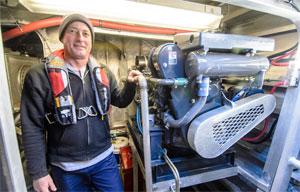 |
 |
|
|
Engineer Steve Ager with one of Blake’s Northern Lights 55-kW generators. |
Right, deck hand and cook Scean Smith prepares chili mac in the vessel’s galley. |
|
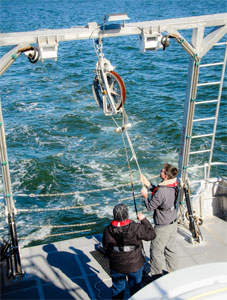 |
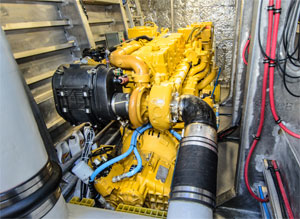 |
|
|
Hydrographers Jason Dorfman and Kathleen Schacht prepare a towed side scanner for |
A Caterpillar C18 main engine. |
|
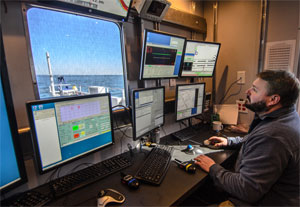 |
||
|
Lead hydrographer John Staly monitors scanner readings on a calibration run. |
||

